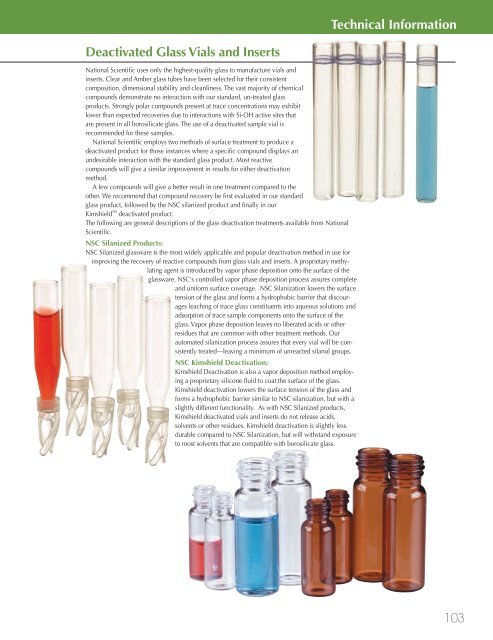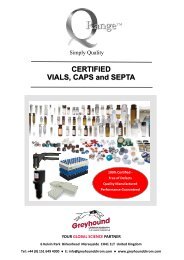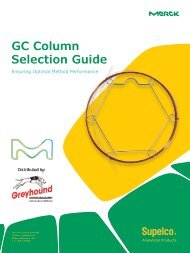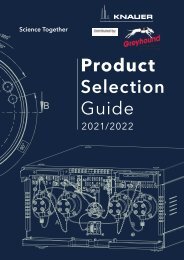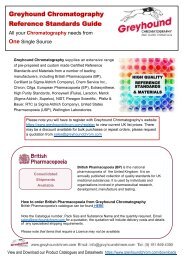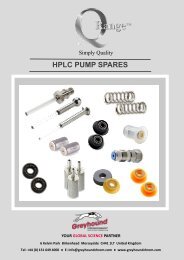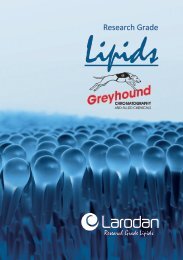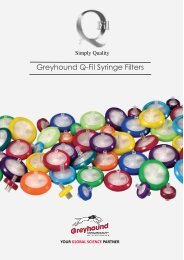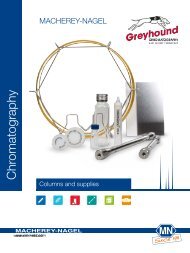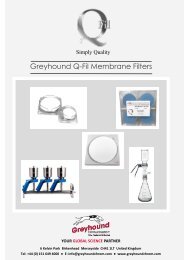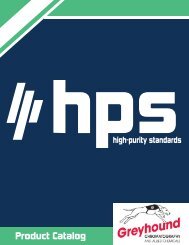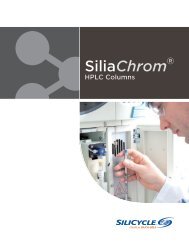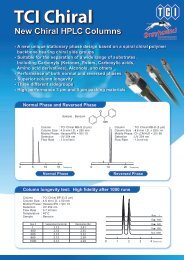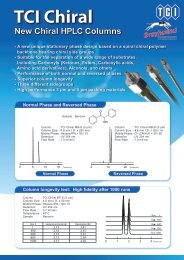National Scientific 2008-9 Catalogue
This catalogue contains product details of products from National Scientific. If you have any questions about National Scientific products or wish to discuss the pricing and delivery of products from this manufacturer, or any of the many other Manufacturers we represent, please do not hesitate to contact us either by email Sales@greyhoundchrom.com or rachel@greyhoundchrom.com (Greyhound Chromatography’s Sales Manager). We are proud of our long-standing relationships with our customers and agents. We value our agent network highly and are constantly looking to appoint new agents with the right expertise, in areas where we are not represented. Please email sales@greyhoundchrom.com if you are interested in becoming one of our agents. Visit https://www.greyhoundchrom.com for a full range of Chromatography consumables, including Certified Reference Standards and Materials, Solvents, Reagents and Laboratory Chemicals.
This catalogue contains product details of products from National Scientific. If you have any questions about National Scientific products or wish to discuss the pricing and delivery of products from this manufacturer, or any of the many other Manufacturers we represent, please do not hesitate to contact us either by email Sales@greyhoundchrom.com or rachel@greyhoundchrom.com (Greyhound Chromatography’s Sales Manager).
We are proud of our long-standing relationships with our customers and agents. We value our agent network highly and are constantly looking to appoint new agents with the right expertise, in areas where we are not represented. Please email sales@greyhoundchrom.com if you are interested in becoming one of our agents.
Visit https://www.greyhoundchrom.com for a full range of Chromatography consumables, including Certified Reference Standards and Materials, Solvents, Reagents and Laboratory Chemicals.
You also want an ePaper? Increase the reach of your titles
YUMPU automatically turns print PDFs into web optimized ePapers that Google loves.
Technical Information<br />
Deactivated Glass Vials and Inserts<br />
<strong>National</strong> <strong>Scientific</strong> uses only the highest-quality glass to manufacture vials and<br />
inserts. Clear and Amber glass tubes have been selected for their consistent<br />
composition, dimensional stability and cleanliness. The vast majority of chemical<br />
compounds demonstrate no interaction with our standard, un-treated glass<br />
products. Strongly polar compounds present at trace concentrations may exhibit<br />
lower than expected recoveries due to interactions with Si-OH active sites that<br />
are present in all borosilicate glass. The use of a deactivated sample vial is<br />
recommended for these samples.<br />
<strong>National</strong> <strong>Scientific</strong> employs two methods of surface treatment to produce a<br />
deactivated product for those instances where a specific compound displays an<br />
undesirable interaction with the standard glass product. Most reactive<br />
compounds will give a similar improvement in results for either deactivation<br />
method.<br />
A few compounds will give a better result in one treatment compared to the<br />
other. We recommend that compound recovery be first evaluated in our standard<br />
glass product, followed by the NSC silanized product and finally in our<br />
Kimshieldq deactivated product.<br />
The following are general descriptions of the glass deactivation treatments available from <strong>National</strong><br />
<strong>Scientific</strong>.<br />
NSC Silanized Products:<br />
NSC Silanized glassware is the most widely applicable and popular deactivation method in use for<br />
improving the recovery of reactive compounds from glass vials and inserts. A proprietary methylating<br />
agent is introduced by vapor phase deposition onto the surface of the<br />
glassware. NSC's controlled vapor phase deposition process assures complete<br />
and uniform surface coverage. NSC Silanization lowers the surface<br />
tension of the glass and forms a hydrophobic barrier that discourages<br />
leaching of trace glass constituents into aqueous solutions and<br />
adsorption of trace sample components onto the surface of the<br />
glass. Vapor phase deposition leaves no liberated acids or other<br />
residues that are common with other treatment methods. Our<br />
automated silanization process assures that every vial will be consistently<br />
treated—leaving a minimum of unreacted silanol groups.<br />
NSC Kimshield Deactivation:<br />
Kimshield Deactivation is also a vapor deposition method employing<br />
a proprietary silicone fluid to coat the surface of the glass.<br />
Kimshield deactivation lowers the surface tension of the glass and<br />
forms a hydrophobic barrier similar to NSC silanization, but with a<br />
slightly different functionality. As with NSC Silanized products,<br />
Kimshield deactivated vials and inserts do not release acids,<br />
solvents or other residues. Kimshield deactivation is slightly less<br />
durable compared to NSC Silanization, but will withstand exposure<br />
to most solvents that are compatible with borosilicate glass.<br />
103


